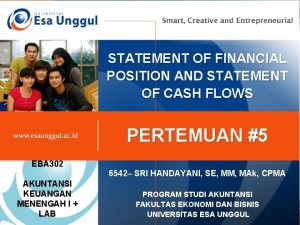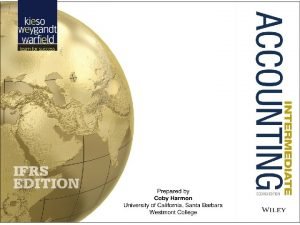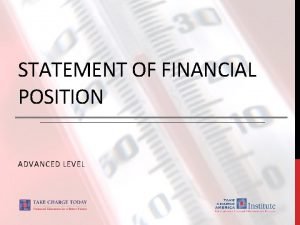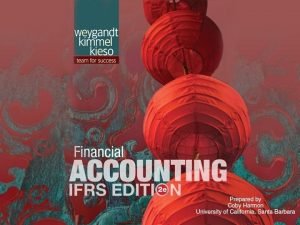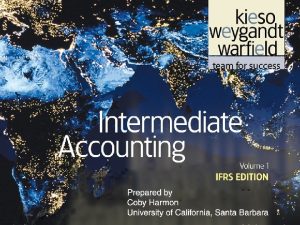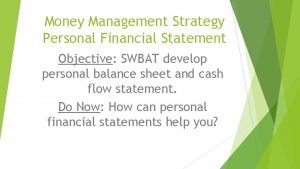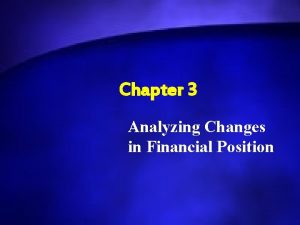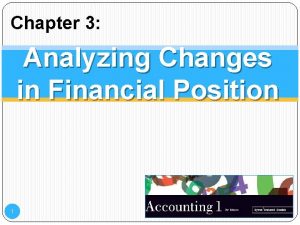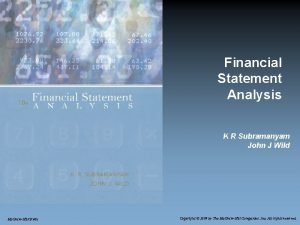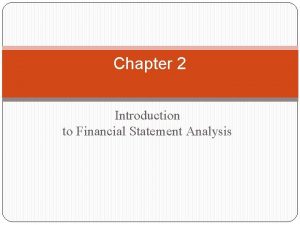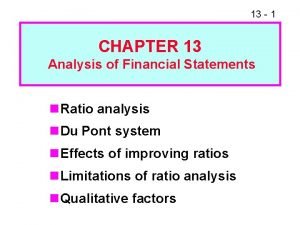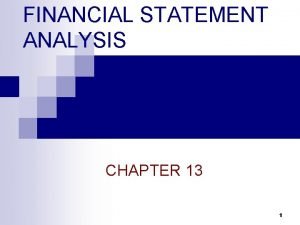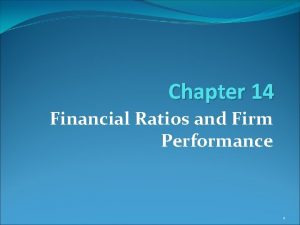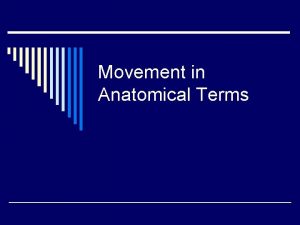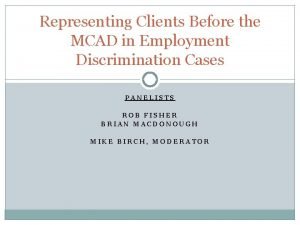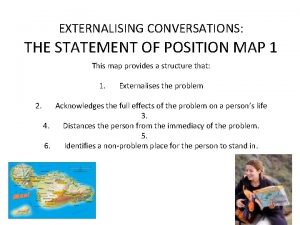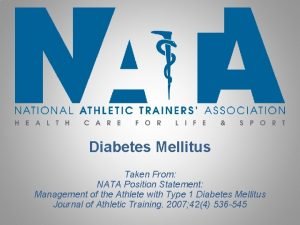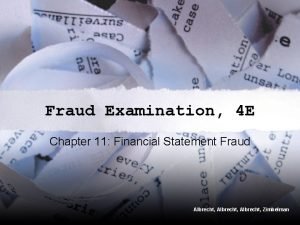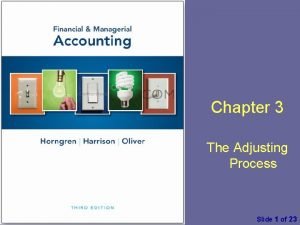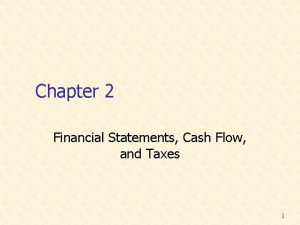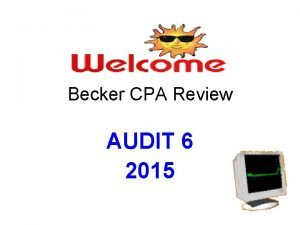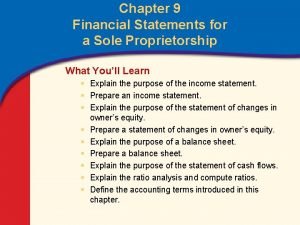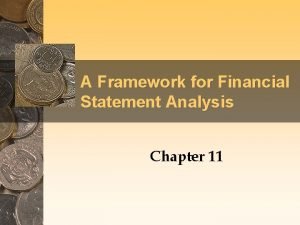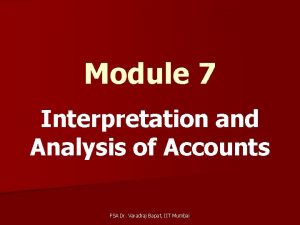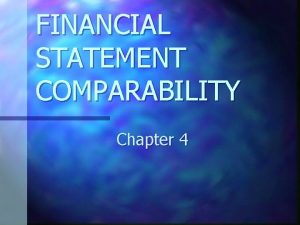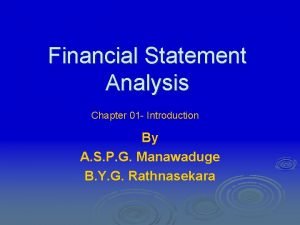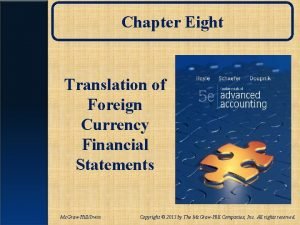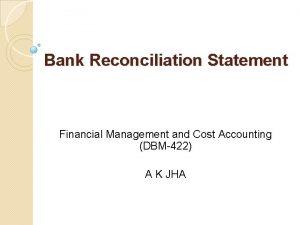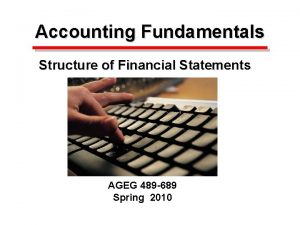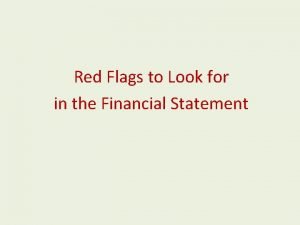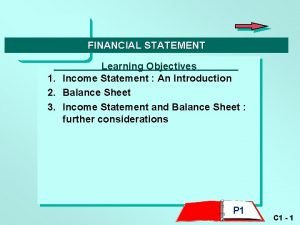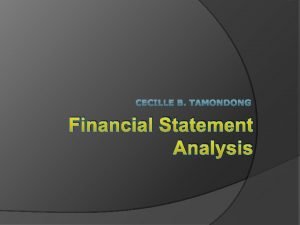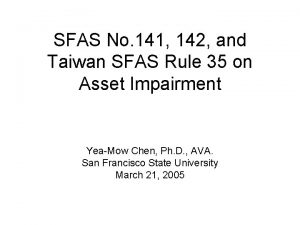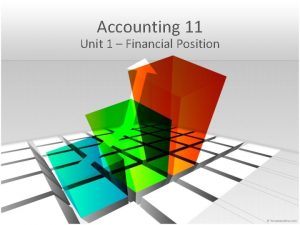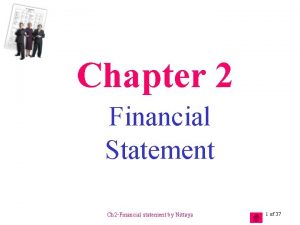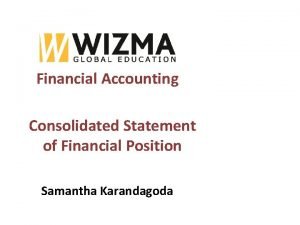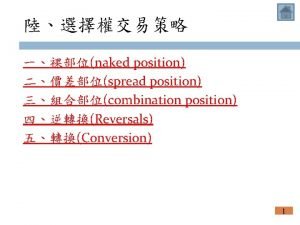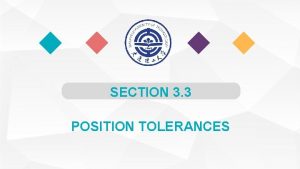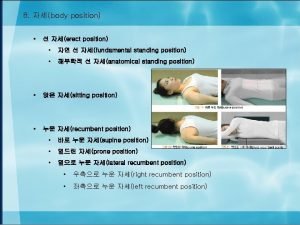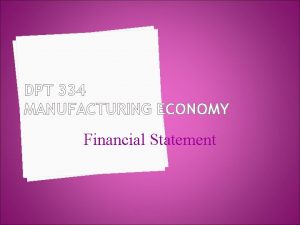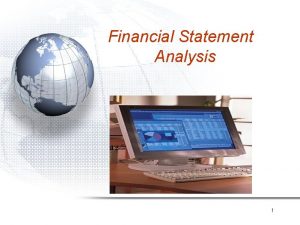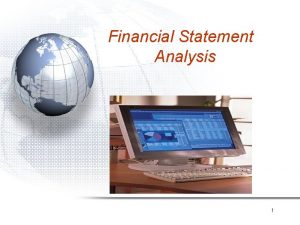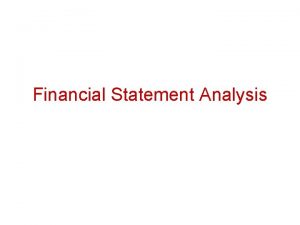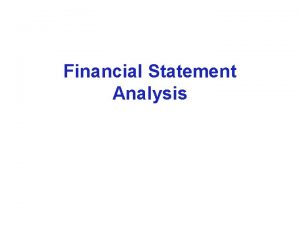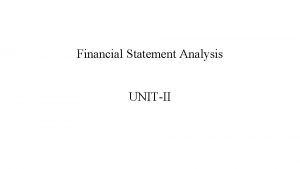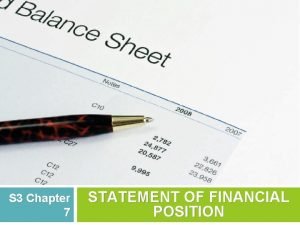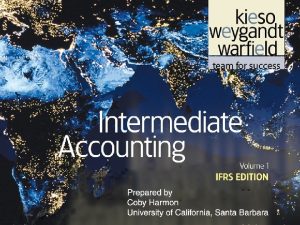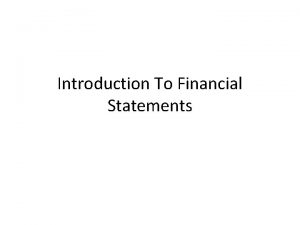5 1 CHAPTER 5 STATEMENT OF FINANCIAL POSITION






















































- Slides: 54

5 -1

CHAPTER 5 STATEMENT OF FINANCIAL POSITION AND STATEMENT OF CASH FLOWS Intermediate Accounting IFRS Edition Kieso, Weygandt, and Warfield 5 -2

Learning Objectives 5 -3 1. Explain the uses and limitations of a statement of financial position. 2. Identify the major classifications of the statement of financial position. 3. Prepare a classified statement of financial position using the report and account formats. 4. Indicate the purpose of the statement of cash flows. 5. Identify the content of the statement of cash flows. 6. Prepare a basic statement of cash flows. 7. Understand the usefulness of the statement of cash flows. 8. Determine additional information requiring note disclosure. 9. Describe the major disclosure techniques for financial statements.

Statement of Financial Position and Statement of Cash Flows Statement of Financial Position 5 -4 Statement of Cash Flows Additional Information Usefulness Purpose Notes Limitations Content and format Classification Preparation Techniques of disclosure Usefulness Other guidelines

Statement of Financial Position, also referred to as the balance sheet: 1. Reports assets, liabilities, and equity at a specific date. 2. Provides information about resources, obligations to creditors, and equity in net resources. 3. Helps in predicting amounts (jumlah), timing (waktu), and uncertainty (ketidakpastian) of future cash flows. 5 -5

Statement of Financial Position Usefulness Analyze company’s: Ø Liquidity jumlah waktu yang diperkirakan dibutuhkan sampai suatu aktiva terealisasi atau sebaliknya dikonversi menjadi kas Rasio ini mengindikasikan apakah perusahaan memiliki sumber daya untuk melunasi kewajiban lancarnya dan yang akan jatuh tempo. Ø Solvency kemampuan perusahaan untuk membayar hutang-hutangnya pada saat jatuh tempo Perusahaan dengan hutang jangka panjang yang tinggi terhadap aktiva, maka solvensi Ø Financial flexibility kemampuan perusahaan untuk mengubah komposisi arus kas sehingga dapat bereaksi terhadap kebutuhan dan peluang tak terduga Perusahaan yang memiliki banyak hutang tidak akan fleksibel secara keuangan. Semakin tinggi fleksibilitas keuangan, semakin kecil risiko kegagalan perusahaan 5 -6

Statement of Financial Position Limitations Most assets and liabilities are reported at historical cost. Use of judgments and estimates. estimasi jumlah piutang yang akan ditagih masa manfaat gudang Many items of financial value are omitted : nilai keuangan bagi perusahaan tetapi tidak bisa dicatat secara objektif : reputasi, nilai karyawan 5 -7

Statement of Financial Position Classification 5 -8 LO 2 Identify the major classifications of the statement of financial position.

Statement of Financial Position Subclassifications Illustration 5 -1 In some countries, such as Germany, companies often list current assets first. IAS No. 1 requires companies to distinguish current assets and liabilities from non-current ones, except in limited situations. 5 -9 LO 2 Identify the major classifications of the statement of financial position.

Classification Non-Current Assets (Aktiva Tidak Lancar) Generally consists of: Long-term Investments (Investasi jangka panjang) Property, Plant, and Equipment (properti atau kekayaan fisik seperti tanah, bangunan, mesin, perabotan, dan perkakas). Intangibles Assets (Aktiva tidak berwujud) : tidak memiliki substansi fisik dan bukan merupakan instrumen keuangan : paten, hak cipta, goodwill, merek dagang, daftar pelanggan. Other Assets : beban di bayar dimuka jangka panjang 5 -10

Classification Non-Current Assets Long-term Investments 1. Securities (bonds, ordinary shares, or long-term notes). 2. Tangible assets not currently used in operations (tanah yang ditahan untuk spekulasi). 3. Special funds (sinking fund, pension fund, or plant expansion fund. 4. Non-consolidated subsidiaries or associated companies. 5 -11

Classification Property, Plant, and Equipment Tangible long-lived assets used in the regular operations of the business. Physical property such as land, buildings, machinery, furniture, tools, and wasting resources (minerals). With the exception of land, a company either depreciates (e. g. , buildings) or depletes (e. g. , oil reserves) these assets. 5 -12

Classification Illustration 5 -3 Statement of Financial Position Presentation of Property, Plant, and Equipment 5 -13 LO 2 Identify the major classifications of the statement of financial position.

Classification Intangible Assets Tidak memiliki substansi fisik dan bukan merupakan instrumen keuangan Patents, copyrights (hak cipta), franchises, goodwill, trademarks (merk), trade names (nama dagang), and customer lists. Diamortisasi selama masa manfaatnya Perusahaan secara periodik menilai umur aktiva tak berwujud (seperti goodwill) berdasarkan penurunan nilai (impairment) yang terjadi. 5 -14

Classification Intangible Assets Illustration 5 -4 Statement of Financial Position Presentation of Intangible Assets 5 -15 LO 2 Identify the major classifications of the statement of financial position.

Classification Current Assets Kas dan aktiva lainnya yang diharapkan akan dapat dikonversi menjadi kas, dijual, atau dikonsumsi dalam satu tahun atau dalam satu siklus operasi, tergantung mana yang paling lama. Illustration 5 -5 5 -16 LO 2 Identify the major classifications of the statement of financial position.

Classification Inventories Disclose: Basis of valuation (e. g. , lower-of-cost-or-market). Cost flow assumption (e. g. , FIFO or average cost). Illustration 5 -6 5 -17 LO 2

Classification Inventories Manufacturing Company Illustration 5 -8 Statement of Financial Position Presentation of Inventories 5 -18 LO 2

Classification Receivables Claims held against customers and others for ü money, ü goods, or ü services. Major categories of receivables should be shown in the statement of financial position or the related notes. 5 -19 LO 2 Identify the major classifications of the statement of financial position.

Classification Receivables Illustration 5 -8 Statement of Financial Position Presentation of Receivables 5 -20 LO 2 Identify the major classifications of the statement of financial position.

Classification Prepaid Expenses Payment of cash, that is recorded as an asset because service or benefit will be received in the future. Cash Payment BEFORE Expense Recorded Prepayments often occur in regard to: insurance supplies advertising 5 -21 rent maintenance on equipment LO 2 Identify the major classifications of the statement of financial position.

Classification Prepaid Expenses 5 -22 Illustration 5 -9 Statement of Financial Position Presentation of Prepaid Expenses LO 2

Classification Short-Term Investments Illustration 5 -10 Statement of Financial Position Presentation of Short-Term Investments 5 -23 LO 2 Identify the major classifications of the statement of financial position.

Classification Cash Generally any monies available “on demand. ” Cash equivalents – investasi jangka pendek yang sangat likuid dan akan jatuh tempo dalam jangka waktu tiga bulan atau kurang. Restrictions or commitments must be disclosed. Illustration 5 -11 5 -24 LO 2 Identify the major classifications of the statement of financial position.

Classification Cash 5 -25 Illustration 5 -12 Statement of Financial Position—Restricted Cash LO 2 Identify the major classifications of the statement of financial position.

Classification Equity 5 -26 LO 2 Identify the major classifications of the statement of financial position.

Classification Equity Ø Ordinary shares and preference shares - must disclose the par value and the authorized, issued, and outstanding amounts. Ø Share premium - company usually presents one amount for ordinary and preference shares. Ø Retained earnings - amount may be divided between the unappropriated and restricted amounts. Ø Treasury shares - shown as a reduction of equity. 5 -27 LO 2 Identify the major classifications of the statement of financial position.

Classification Equity Illustration 5 -13 Statement of Financial Position—Equity 5 -28 LO 2 Identify the major classifications of the statement of financial position.

Classification Non-Current Liabilities Kewajiban yang diperkirakan tidak dapat dilunasi (dilikuidasi) dalam siklus operasi yang normal. 1. Kewajiban dari situasi pembiayaan khusus : penerbitan obligasi, kewajiban lease jangka panjang. 2. Kewajiban yang berasal dari operasi normal perusahaan : kewajiban pensiun 3. Kewajiban yang tergantung pada terjadi atau tidak terjadinya satu kejadian atau lebih di masa depan untuk mengkonfirmasi jumlah yang harus di bayar 5 -29 LO 2 Identify the major classifications of the statement of financial position.

Classification Non-Current Liabilities Illustration 5 -15 Statement of Financial Position Presentation of Non -Current Liabilities 5 -30 LO 2 Identify the major classifications of the statement of financial position.

Classification Current Liabilities Obligations that a company generally expects to settle in its normal operating cycle or one year, whichever is longer. This concept includes: 1. Payables resulting from the acquisition of goods and services: accounts payable, wages payable, and so on. 2. Collections received in advance for the delivery of goods or performance of services, such as unearned rent revenue. 3. Other liabilities whose liquidation will take place within the operating cycle or one year. 5 -31 LO 2 Identify the major classifications of the statement of financial position.

Classification Current Liabilities Illustration 5 -16 Statement of Financial Position Presentation of Current Liabilities 5 -32 LO 2 Identify the major classifications of the statement of financial position.

Classification Statement of Financial Position Format IFRS does not specify the order or format in which a company presents items in the statement of financial position. Account form or report form. 5 -33 LO 3 Prepare a classified statement of financial position using the report and account formats.

Classification Account Form 5 -34 Illustration 5 -17 LO 3 Prepare a classified statement of financial position using the report and account formats.

Classification Report Form Illustration 5 -17 5 -35 LO 3

The Statement of Cash Flows One of the three basic objectives of financial reporting is “assessing the amounts, timing, and uncertainty of cash flows. ” IASB requires the statement of cash flows (also called the cash flow statement). 5 -36

Purpose of the Statement of Cash Flows Primary Purpose: menyediakan informasi yang relevan mengenai penerimaan dan pembayaran kas sebuah perusahaan selama suatu periode. The statement provides answers to the following questions: 1. Where did the cash come from? 2. What was the cash used for? 3. What was the change in the cash balance (perubahan saldo kas) ? 5 -37 LO 4 Indicate the purpose of the statement of cash flows.

Content and Format 5 -38 Operating Investing Financing Cash inflows and outflows from operations. Cash inflows and outflows from non -current assets. Cash inflows and outflows from non -current liabilities and equity. Pengaruh kas dari transaksi yang digunakan untuk menentukan net income Perolehan dan pelepasan investasi a. b. c. Perolehan sumber daya dari pemilik Pengembalian investasi Peminjaman uang dari kreditor dan pelunasan

Content and Format Illustration 5 -19 5 -39

Preparation of the Statement of Cash Flows Pembuatan Laporan Arus Kas Informasi untuk membuat laporan arus kas biasanya berasal dari : (1) Neraca komparatif, (2) Laporan laba rugi (income statement), and (3) data-data transaksi terpilih. 5 -40 LO 6 Prepare a basic statement of cash flows.

Preparation of the Statement of Cash Flows: Telemarketing Inc. dalam tahun pertama operasinya pada tanggal 1 Januari 2011 menerbitkan 50, 000 lembar saham biasa dengan nilai pari $1 seharga $50, 000 tunai. Perusahaan menyewakan ruang kantor, perabotan, dan peralatan telekomunikasi serta melaksanakan survey dan jasa pemasaran sepanjang tahun pertama. Pada bulan Juni 2011, perusahaan membeli tanah seharga $15, 000. Neraca komparatif pada awal dan akhir tahun 2011 ditunjukkan dalam ilustrasi 5 -20. Laporan laba rugi Telemarketing, Inc. dan informasi tambahannya disajikan pada ilustrasi 5. 21 5 -41

Preparation of the Statement of Cash Flows Illustration 5 -20 Illustration 5 -21 5 -42 LO 6

Preparation of the Statement of Cash Flows Preparing the Statement of Cash Flows Tentukan: 1. Kas yang disediakan oleh aktivitas atau digunakan dalam operasi. 2. Kas yang disediakan oleh atau digunakan dalam aktivitas investasi dan pembiayaan 3. Penentuan perubahan (kenaikan atau penurunan) kas selama periode berjalan. 4. Rekonsiliasi perubahan kas dengan saldo kas awal dan saldo kas akhir. 5 -43 LO 6 Prepare a basic statement of cash flows.

Preparation of the Statement of Cash Flows Illustration 5 -20 Cash provided by operating activities 5 -44 Illustration 5 -21 Illustration 5 -22 LO 6 Prepare a basic statement of cash flows.

Illustration 5 -20 Illustration 5 -21 Illustration 5 -29 The Statement of Cash Flows Next, the company determines its investing and financing activities. 5 -45

Preparation of the Statement of Cash Flows (BE 5 -12): Keyser Beverage Company reported the following items in the most recent year. Activity Net income Dividends paid Increase in accounts receivable Increase in accounts payable Purchase of equipment Depreciation expense Issue of notes payable $40, 000 Operating 5, 000 10, 000 7, 000 8, 000 4, 000 20, 000 Financing Operating Investing Operating Financing Required: Prepare a Statement of Cash Flows 5 -46 LO 6 Prepare a basic statement of cash flows.

Preparation of the Statement of Cash Flows Review In preparing a statement of cash flows, which of the following transactions would be considered an investing activity? 5 -47 a. Sale of equipment at book value b. Sale of merchandise on credit c. Declaration of a cash dividend d. Issuance of bonds payable. LO 6 Prepare a basic statement of cash flows.

Preparation of the Statement of Cash Flows Significant Non-Cash Activities Aktivitas pembiayaan dan investasi yang signifikan yang tidak mempengaruhi kas tidak dilaporkan pada laporan arus kas dalam skedul terpisah di bagian bawah laporan arus kas. Contoh : Issuance of ordinary shares to purchase assets. Conversion of bonds into ordinary shares. Penerbitan surat utang untuk membeli aktiva. Pertukaran aktiva jangka panjang. 5 -48

Preparation of the Statement of Cash Flows Illustration 5 -24 Comprehensive Statement of Cash Flows 5 -49

Usefulness of the Statement of Cash Flows Without cash, a company will not survive. Cash flow from Operations: High amount –kas bersih yang disediakan oleh aktivitas operasi tinggi perusahaan mampu membayar kewajiban tanpa harus meminjam dari luar. Low amount –kas bersih yang disediakan oleh aktivitas operasi rendah perusahaan harus meminjam atau menerbitkan sekuritas ekuitas untuk mendapatkan kas tambahan untuk membayar kewajibannya 5 -50

Usefulness of the Statement of Cash Flows Financial Liquidity Current Cash Debt Coverage = Ratio Illustration 5 -26 Net Cash Provided by Operating Activities Average Current Liabilities Rasio ini mengindikasikan apakah perusahaan dapat melunasi kewajiban lancarnya dari operasinya 5 -51 LO 7 Understand the usefulness of the statement of cash flows.

Usefulness of the Statement of Cash Flows Financial Flexibility Cash Debt Coverage Ratio = Illustration 5 -27 Net Cash Provided by Operating Activities Average Total Liabilities Rasio ini mengindikasikan kemampuan perusahaan untuk membayar kembali kewajibannya dengan kas bersih dari aktivitas operasi, tanpa harus menjual / melikuidasi aktiva yang digunakan dalam operasi. 5 -52 LO 7 Understand the usefulness of the statement of cash flows.

Usefulness of the Statement of Cash Flows Free Cash Flow Illustration 5 -29 The amount of discretionary cash flow a company has for purchasing additional investments, retiring its debt (melunasi hutang) , purchasing treasury stock, or simply adding to its liquidity. Membeli investasi tambahan, melunasi hutang, membeli saham treasury, atau hanya untuk menambah likuiditas perusahaan. 5 -53

Copyright © 2011 John Wiley & Sons, Inc. All rights reserved. Reproduction or translation of this work beyond that permitted in Section 117 of the 1976 United States Copyright Act without the express written permission of the copyright owner is unlawful. Request for further information should be addressed to the Permissions Department, John Wiley & Sons, Inc. The purchaser may make back-up copies for his/her own use only and not for distribution or resale. The Publisher assumes no responsibility for errors, omissions, or damages, caused by the use of these programs or from the use of the information contained herein. 5 -54
 Second position
Second position Statement of financial position
Statement of financial position Statement of financial position account form
Statement of financial position account form Report form statement of financial position
Report form statement of financial position Statement of financial position assets
Statement of financial position assets Accounting for merchandising activities
Accounting for merchandising activities Classified statement of financial position
Classified statement of financial position Financial position account form
Financial position account form Personal statement of financial position
Personal statement of financial position Equation analysis sheet
Equation analysis sheet Chapter 3 analyzing changes in financial position answers
Chapter 3 analyzing changes in financial position answers Chapter 3 analyzing changes in financial position answers
Chapter 3 analyzing changes in financial position answers Summary of ratio analysis
Summary of ratio analysis Kr subramanyam
Kr subramanyam Chapter 14 financial statement analysis solutions
Chapter 14 financial statement analysis solutions Chapter 2 financial statement analysis solutions
Chapter 2 financial statement analysis solutions Chapter 13 financial statement analysis
Chapter 13 financial statement analysis Analysis of financial statements
Analysis of financial statements Chapter 1 overview of financial statement analysis
Chapter 1 overview of financial statement analysis Chapter 14 financial statement analysis
Chapter 14 financial statement analysis Fundamental position vs anatomical position
Fundamental position vs anatomical position Fundamental positions
Fundamental positions Financial methods of motivation
Financial methods of motivation Mcad rebuttal to position statement
Mcad rebuttal to position statement Statement of position map narrative therapy
Statement of position map narrative therapy Thesis statement for censorship
Thesis statement for censorship Nata diabetes
Nata diabetes Closed thesis statement
Closed thesis statement Purposes of financial statements
Purposes of financial statements Financial statement robert kiyosaki
Financial statement robert kiyosaki Parent financial statement
Parent financial statement Nature of financial statement
Nature of financial statement Income statement in financial accounting
Income statement in financial accounting Financial statement in millions
Financial statement in millions Becker & smith cpas performs
Becker & smith cpas performs Inhouse financial statement
Inhouse financial statement Partnership income statement format
Partnership income statement format Becomes weakness
Becomes weakness Chapter 9 financial statements for a sole proprietorship
Chapter 9 financial statements for a sole proprietorship Financial statement analysis framework
Financial statement analysis framework Parents financial statement
Parents financial statement Objectives of financial statement analysis
Objectives of financial statement analysis Horizontal analysis interpretation
Horizontal analysis interpretation Financial statement comparability
Financial statement comparability Introduction of financial statement analysis
Introduction of financial statement analysis Banks income statement analysis
Banks income statement analysis Financial statement translation example
Financial statement translation example Cost accounting reconciliation statement
Cost accounting reconciliation statement Structure of financial statements
Structure of financial statements Financial statement red flags
Financial statement red flags Parents financial statement
Parents financial statement Parents' financial statement sample
Parents' financial statement sample Carriage on sales in income statement
Carriage on sales in income statement Solvency investopedia
Solvency investopedia Sfas 141
Sfas 141


